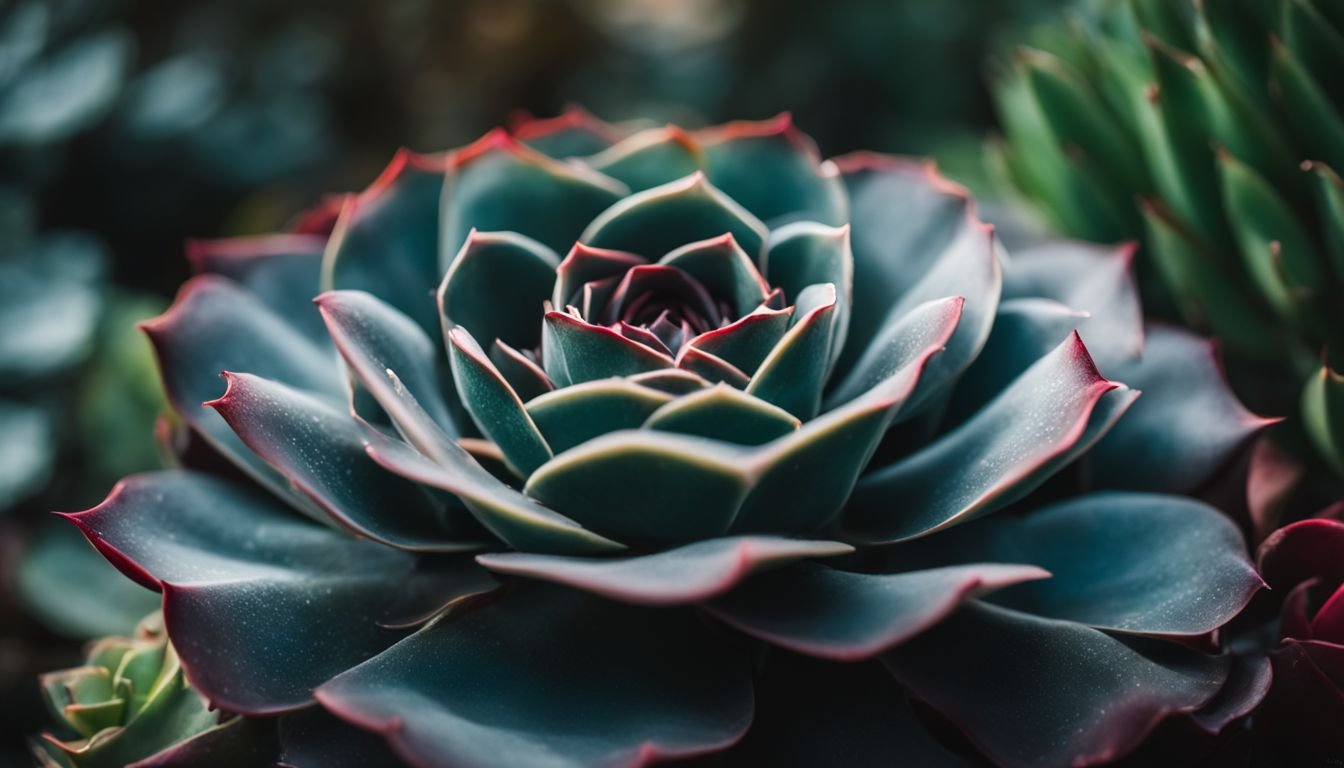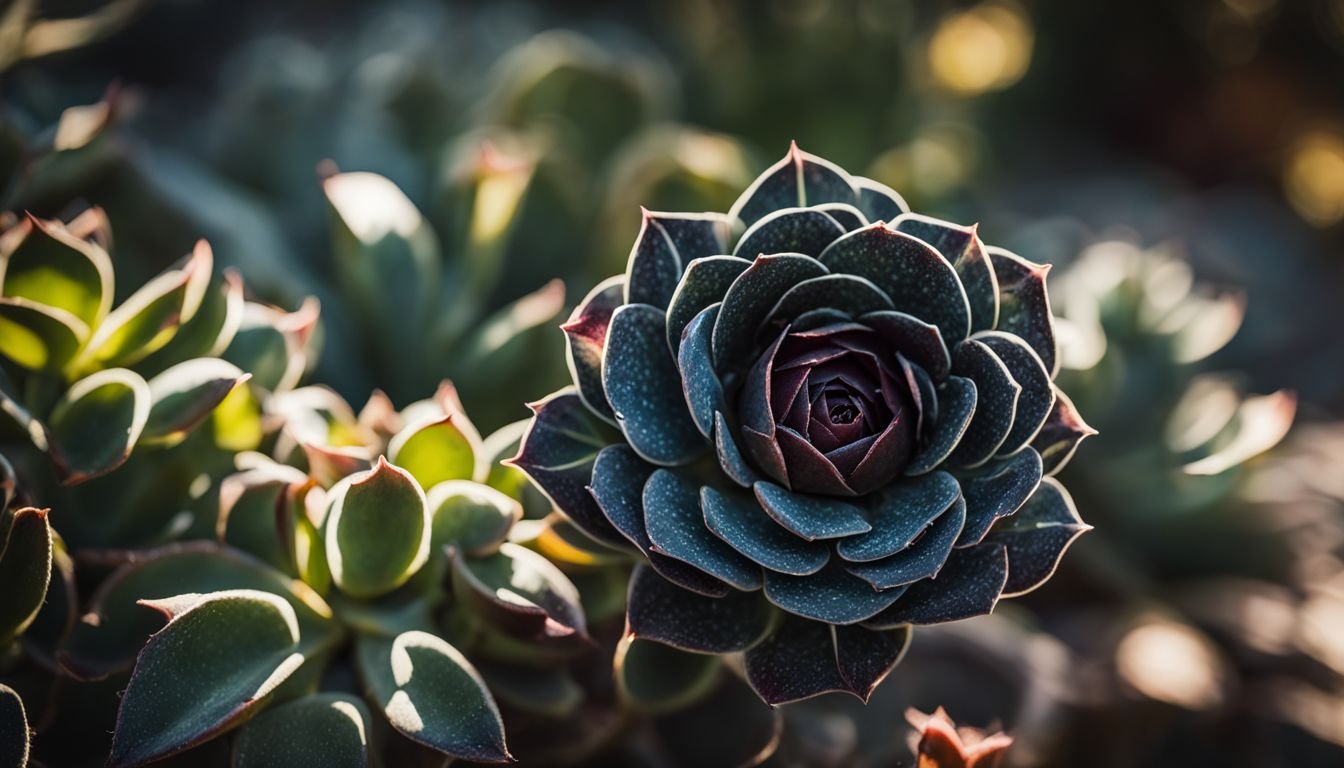Ever found yourself fretting over your Black Rose succulent, watching it look a tad under the weather, shedding leaves or not flowering as brilliantly as you hoped? Believe me, we’ve walked that path too.
It’s a real challenge to see a plant you’ve put effort into caring for not doing its best, especially when the solution seems as clear as mud. After heaps of research and drawing on our own trials and errors, we’ve cracked the code on how to give these distinct plants the leg up they need.
The Aeonium Arboreum ‘Zwartkop’, or the Black Rose succulent as it’s fondly known, is an absolute stunner that thrives in plenty of sunshine and can turn any garden or living space into a sight for sore eyes with just a bit of TLC.
Getting the mix right – from water to soil blend, to catching those rays – can really make all the difference. Our guide is chock-a-block with tips on finding this sweet spot, keeping root rot at bay (a common hiccup when enthusiasm leads to overwatering), and tackling pesky critters set on troubling your Black Rose.
Keen for happier plants?
Key Takeaways
- The Black Rose Succulent thrives in well – draining soil and plenty of sunlight, making it a standout addition to any garden or indoor arrangement.
- Water these plants sparingly, letting the potting mix dry out completely before watering again to avoid root rot, especially during cooler weather when they need even less water.
- Protect your Black Rose Succulent from extreme heat by providing afternoon shade on hot days and ensure it’s not exposed to frost or cold drafts during winter.
- Watch out for pests like aphids and mealybugs that can harm your plant. Use insecticidal soap or dab with alcohol on a cotton swab to keep them at bay.
- Propagating the Black Rose is easy with stem cuttings; let them dry for a day or two then plant in well-draining soil, offering an effective way to expand your collection.
Understanding the Black Rose Succulent

The Black Rose Succulent, officially known as Aeonium arboreum ‘Zwartkop’, stands out in any garden design. Its dark, rosette-shaped leaves capture the eye, making it a stunning choice for Australian plant enthusiasts.
This succulent thrives in conditions that mimic its native habitat – ample sunlight and well-drained soil are key. We make sure our plants get plenty of light to stay healthy and vibrant.
“Aeonium arboreum ‘Zwartkop’ is a true gem in drought-tolerant garden planting.”
Caring for this unique houseplant doesn’t require constant attention. It’s quite hardy, surviving temperatures between 21-29 degrees Celsius comfortably and can even handle down to -1 degrees Celsius with ease.
During summer or extreme heat, it enters a dormant phase, shedding leaves to conserve energy. This might look alarming at first but don’t worry; it bounces back once the weather cools down.
For watering, less is more with this succulent; we wait until the potting mix is dry before giving it a drink to avoid root rot issues.
How to Care for the Black Rose Succulent

Caring for the Black Rose Succulent, or Aeonium arboreum ‘Zwartkop’, means getting a few things just right. This stunning plant thrives with the proper mix of sunlight, water, and soil.
Firstly, let’s talk about how often to water these drought-resistant plants. They need less water than you might think. It’s best to let their potting mix dry out completely before giving them a good soak.
Choosing the right potting mix is crucial too. These succulents prefer well-draining soil that mimics their natural habitat. Adding some sand or perlite to your regular potting mix can do wonders.
Sunlight and temperature also play big roles in keeping your Black Rose vibrant. They love basking in full sun but handle partial shade well during hotter months. As for temperature, they enjoy warmth but can tolerate cooler conditions during winter as long as they’re not too harsh.
All up, mastering these care essentials will help your Black Rose Succulent
Watering Requirements
We need to water our Aeonium Black Rose succulents carefully. In summer, these plants like a drink every 7 days. But as the weather cools down, they prefer it every 12 days. We always check the humidity in our area before watering because these plants don’t like too much water.
Growing them outside? We pay extra attention to their thirst schedule. Overwatering is bad news for them because it can lead to root rot – something we definitely want to avoid with our precious houseplants.
For those of us trying to keep these beauties indoors, light plays a big role in how often they need water. If they bask in full sun, we might have to water them differently than if they were chilling in partial shade.
This balancing act ensures our tree aeoniums thrive without getting their roots soaked or drying out.
Soil Requirements
For a thriving Black Rose Succulent, choosing the right soil is crucial. These plants love soil that drains well, preventing water from lingering around their roots too long. Mixing cactus potting mix with perlite creates the perfect home for them.
In drier conditions, aim for a blend of two parts cactus mix to one part perlite. If you’re gardening in more humid areas, equal parts of each work best.
“The right soil mixture makes all the difference to a succulent’s health.”
If you’re planning to propagate Aeonium Arboreum ‘Zwartkop’ using stem cuttings, it’s essential to start them off right. After allowing the cuttings to dry and form a callous over a few days, plant them in this well-draining mix to encourage healthy root growth without rot setting in.
This way, your new plants get the strongest possible start in your garden or nursery garden designs.
Light and Temperature Needs
Caring for a Black Rose Succulent means paying close attention to its light and temperature needs. These plants adore the sun but require special care to thrive.
- Aim for lots of light: The Aeonium Black Rose loves soaking up the sunshine. Make sure it gets plenty of bright light every day. This encourages healthy growth. If you’re growing one indoors, a sunny window is perfect.
- Start with partial shade: If your plant is new to outdoor conditions, begin with partial shade. This helps it get used to the sunlight without stressing it too much.
- Gradually increase sun exposure: After the initial period in partial shade, slowly let your Black Rose Aeonium experience more direct sunlight. This method avoids leaf burn and ensures your plant adapts well.
- Watch out for scorching summer days: While these succulents can handle heat, extremely hot days can harm them. On such days, provide some afternoon shade or bring your plant indoors if possible.
- Keep temperatures in check: Your Black Rose will flourish in warm conditions between 21-29 degrees Celsius but can survive down to nearly -1 degree Celsius for brief periods. Ensure you protect it from severe winter chills.
- Avoid cold drafts and frost: Place your plant where it won’t be hit by cold winds or risk frost damage during cooler months. Moving pots inside or into a sheltered spot outside can help.
- Use potting mix that drains well: Good drainage is vital for these plants because soggy roots can lead to issues, especially in cooler weather.
By focusing on these light and temperature tips, your Black Rose Succulent should continue beautifying your garden or home without much hassle.
Potential Issues with Black Rose Succulent
Even the toughest plants have their weak spots, and the Black Rose Succulent is no different. It can face threats from tiny bugs and illness. Knowing how to deal with these issues means your plant keeps its beauty for longer.
Keep reading to find out how to keep your succulent happy and healthy.
Common Pests and Diseases
Keeping our beloved Black Rose Succulent healthy means we need to stay alert for pests and diseases. These plants, part of the crassulaceae family, can face a few common issues that we’ve got to watch out for.
- Aphids grab our attention first. You might see these small critters in green or black, feasting on the leaves or blooms of our plants. They’re pesky but manageable. A quick spray with insecticidal soap usually sends them packing.
- Mealybugs follow close behind as a threat. These little invaders look like tiny white fluffs hiding in nooks of our plant. If you spot them, it’s time to act fast. Dabbing them with alcohol on a cotton swab works wonders in getting rid of them.
- Overwatering leads to root rot, a serious issue for any succulent including ours. This is where the choice of potting soil really matters; it needs to be fast draining to prevent water from pooling around the roots.
- Lastly, sunburn can trouble our Black Rose if it gets too much direct sunlight during the hottest parts of the day. It loves light but prefers it bright yet indirect.
We keep an eye out for these issues and act swiftly at the first sign of trouble to ensure our Black Rose Succulent thrives beautifully in its environment.
Propagation and Blooming Concerns
We find it straightforward to propagate the Black Rose Succulent. To do so, we use stem cuttings. After cutting, let them dry for a day or two. Then, plant them in well-draining soil and water lightly until they take root.
This process allows us to grow new plants easily at home.
The Black Rose Succulent dazzles with its yellow flowers that stand out against the dark leaves. These blooms add a striking contrast in our gardens during blooming season. Keep an eye on your plant’s dormancy period over summer or extreme heat; it might shed leaves and look less lively but will return to its full glory as temperatures cool down.
Next up, let’s explore potential issues you might face with your Black Rose Succulent.
Conclusion
Caring for a Black Rose succulent offers joy and a touch of beauty to any plant lover’s collection. By following simple steps like providing enough light, using the right soil mix, and watering correctly, this drought-tolerant rosette thrives.
Stay alert for pests such as Aphids and Mealybugs but know these can be managed with attention and care. With patience, your succulent will flourish indoors or outside, adding a unique charm to your garden or home space.
This guide aims to help every Australian gardener succeed in growing their Black Rose succulents healthily and vibrantly.
FAQs
1. What makes the Black Rose Succulent special?
The Black Rose Succulent is a unique plant with a rosette shape, known for its drought-tolerant nature, making it perfect for dry climates.
2. How often should I water my Black Rose Succulent?
Since this succulent plant is drought tolerant, you only need to water it when the soil completely dries out.
3. Can the Black Rose Succulent grow well indoors?
Yes! With enough sunlight, your Black Rose Succulent can thrive indoors as well as it does outdoors.
4. What’s the best way to ensure my Black Rose Succulent stays healthy?
Make sure your succulent gets plenty of light and avoid overwatering to keep its rosette form beautiful and healthy.
